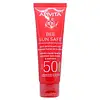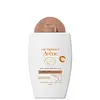Apivita Natural Cosmetics Bee Sun Safe Anti-Spot & Anti-Age Defense Tinted Face Cream SPF50 Versus Avène SPF 50+ Tinted Mineral Fluid
What's inside
What's inside
 Key Ingredients
Key Ingredients

 Benefits
Benefits

 Concerns
Concerns

 Ingredients Side-by-side
Ingredients Side-by-side

Water
Skin ConditioningCI 77891
Cosmetic ColorantDiethylamino Hydroxybenzoyl Hexyl Benzoate
UV FilterPropanediol
SolventBis-Ethylhexyloxyphenol Methoxyphenyl Triazine
Skin ConditioningEthylhexyl Triazone
UV AbsorberEthylhexyl Salicylate
UV AbsorberDicaprylyl Carbonate
EmollientC9-12 Alkane
SolventIsoamyl Laurate
EmollientSilica
AbrasiveGlycerin
HumectantCI 77492
Cosmetic ColorantGlyceryl Stearate Citrate
EmollientSodium Stearoyl Glutamate
CleansingPentylene Glycol
Skin ConditioningParfum
MaskingHydrolyzed Algin
Maris Aqua
HumectantChlorella Vulgaris Extract
Skin ConditioningLaminaria Digitata Extract
Skin ProtectingPropolis Extract
Skin ConditioningAchillea Millefolium Extract
CleansingCrithmum Maritimum Extract
Skin ConditioningRosmarinus Officinalis Leaf Extract
AntimicrobialRosa Canina Fruit Extract
AstringentPanthenol
Skin ConditioningAloe Barbadensis Leaf Juice Powder
Skin ConditioningBrassica Campestris Seed Oil
Skin ConditioningSodium Hyaluronate
HumectantBisabolol
MaskingHydrogenated Lecithin
EmulsifyingCoco-Caprylate/Caprate
EmollientTocopheryl Acetate
AntioxidantHydroxypropyl Cyclodextrin
MaskingEthylhexylglycerin
Skin ConditioningDisodium EDTA
Triacontanyl Pvp
HumectantXanthan Gum
EmulsifyingHydroxyacetophenone
AntioxidantCitronellyl Methylcrotonate
MaskingCitric Acid
BufferingCI 77491
Cosmetic ColorantCI 77499
Cosmetic ColorantWater, CI 77891, Diethylamino Hydroxybenzoyl Hexyl Benzoate, Propanediol, Bis-Ethylhexyloxyphenol Methoxyphenyl Triazine, Ethylhexyl Triazone, Ethylhexyl Salicylate, Dicaprylyl Carbonate, C9-12 Alkane, Isoamyl Laurate, Silica, Glycerin, CI 77492, Glyceryl Stearate Citrate, Sodium Stearoyl Glutamate, Pentylene Glycol, Parfum, Hydrolyzed Algin, Maris Aqua, Chlorella Vulgaris Extract, Laminaria Digitata Extract, Propolis Extract, Achillea Millefolium Extract, Crithmum Maritimum Extract, Rosmarinus Officinalis Leaf Extract, Rosa Canina Fruit Extract, Panthenol, Aloe Barbadensis Leaf Juice Powder, Brassica Campestris Seed Oil, Sodium Hyaluronate, Bisabolol, Hydrogenated Lecithin, Coco-Caprylate/Caprate, Tocopheryl Acetate, Hydroxypropyl Cyclodextrin, Ethylhexylglycerin, Disodium EDTA, Triacontanyl Pvp, Xanthan Gum, Hydroxyacetophenone, Citronellyl Methylcrotonate, Citric Acid, CI 77491, CI 77499
Zinc Oxide
Cosmetic ColorantWater
Skin ConditioningTitanium Dioxide
Cosmetic ColorantCoco-Caprylate/Caprate
EmollientIsocetyl Stearoyl Stearate
EmollientIsopropyl Palmitate
EmollientIsodecyl Neopentanoate
EmollientIsododecane
EmollientIsohexadecane
EmollientPtfe
Triethylhexanoin
MaskingDicaprylyl Ether
EmollientPEG-30 Dipolyhydroxystearate
EmulsifyingCI 77492
Cosmetic ColorantMica
Cosmetic ColorantAlumina
AbrasiveStearic Acid
CleansingCaprylyl Glycol
EmollientPEG-45/Dodecyl Glycol Copolymer
Emulsion StabilisingSilica
AbrasiveBenzoic Acid
MaskingCaprylic/Capric Triglyceride
MaskingDisodium EDTA
Disteardimonium Hectorite
StabilisingGlyceryl Behenate
EmollientGlyceryl Dibehenate
EmollientHelianthus Annuus Seed Oil
EmollientPentaerythrityl Tetra-Di-T-Butyl Hydroxyhydrocinnamate
AntioxidantHydrocinnamyl Cinnamate
PerfumingPolyamide-3
Sodium Chloride
MaskingCI 77891
Cosmetic ColorantTocopheryl Acetate
AntioxidantTocopheryl Glucoside
EmollientTribehenin
EmollientTriethoxycaprylylsilane
Zinc Oxide, Water, Titanium Dioxide, Coco-Caprylate/Caprate, Isocetyl Stearoyl Stearate, Isopropyl Palmitate, Isodecyl Neopentanoate, Isododecane, Isohexadecane, Ptfe, Triethylhexanoin, Dicaprylyl Ether, PEG-30 Dipolyhydroxystearate, CI 77492, Mica, Alumina, Stearic Acid, Caprylyl Glycol, PEG-45/Dodecyl Glycol Copolymer, Silica, Benzoic Acid, Caprylic/Capric Triglyceride, Disodium EDTA, Disteardimonium Hectorite, Glyceryl Behenate, Glyceryl Dibehenate, Helianthus Annuus Seed Oil, Pentaerythrityl Tetra-Di-T-Butyl Hydroxyhydrocinnamate, Hydrocinnamyl Cinnamate, Polyamide-3, Sodium Chloride, CI 77891, Tocopheryl Acetate, Tocopheryl Glucoside, Tribehenin, Triethoxycaprylylsilane
Ingredients Explained
These ingredients are found in both products.
Ingredients higher up in an ingredient list are typically present in a larger amount.
Ci 77492 is also hydrated iron III oxide. It's sole purpose is to give a yellow hue to products.
Iron III oxides are classified as inorganic chemicals for coloring.
Synthetically created Ci 77492 is considered safer than those naturally found. This is because the synthetically created version may contain less impurities. Iron oxides are generally non-toxic and non-allergenic.
Learn more about CI 77492Ci 77891 is a white pigment from Titanium dioxide. It is naturally found in minerals such as rutile and ilmenite.
It's main function is to add a white color to cosmetics. It can also be mixed with other colors to create different shades.
Ci 77891 is commonly found in sunscreens due to its ability to block UV rays.
Learn more about CI 77891Coco-Caprylate/Caprate is created from fatty coconut alcohol, caprylic acid, and capric acid.
It is a lightweight emollient. Emollients create a thin barrier on the skin to trap moisture in. This helps keep your skin hydrated and soft.
Once applied, Coco-Caprylate/Caprate is absorbed quickly and leaves a silky feel.
Coco-Caprylate/Caprate may not be fungal acne safe.
Learn more about Coco-Caprylate/CaprateDisodium EDTA plays a role in making products more stable by aiding other preservatives.
It is a chelating agent, meaning it neutralizes metal ions that may be found in a product.
Disodium EDTA is a salt of edetic acid and is found to be safe in cosmetic ingredients.
Learn more about Disodium EDTASilica, also known as silicon dioxide, is a naturally occurring mineral. It is used as a fine, spherical, and porous powder in cosmetics.
Though it has exfoliant properties, the function of silica varies depending on the product.
The unique structure of silica enhances the spreadability and adds smoothness, making it a great texture enhancer.
It is also used as an active carrier, emulsifier, and mattifier due to its ability to absorb excess oil.
In some products, tiny microneedles called spicules are made from silica or hydrolyzed sponge. When you rub them in, they lightly polish away dead skin layers and enhance the penetration of active ingredients.
Learn more about SilicaTocopheryl Acetate is AKA Vitamin E. It is an antioxidant and protects your skin from free radicals. Free radicals damage the skin by breaking down collagen.
One study found using Tocopheryl Acetate with Vitamin C decreased the number of sunburned cells.
Tocopheryl Acetate is commonly found in both skincare and dietary supplements.
Learn more about Tocopheryl AcetateWater. It's the most common cosmetic ingredient of all. You'll usually see it at the top of ingredient lists, meaning that it makes up the largest part of the product.
So why is it so popular? Water most often acts as a solvent - this means that it helps dissolve other ingredients into the formulation.
You'll also recognize water as that liquid we all need to stay alive. If you see this, drink a glass of water. Stay hydrated!
Learn more about Water